Taking care of your fly fishing gear is essential to ensure its longevity and peak performance. By following a maintenance schedule, you can keep your gear in top shape and ready for your next fishing adventure.
Proper maintenance of your fly fishing gear is crucial for several reasons. It helps prevent damage to your gear, extends its lifespan, and ensures that it performs well when you need it. By following a maintenance schedule, you can address any issues early on and keep your gear in optimal condition.
Key Takeaways:
- Regular maintenance is necessary to keep your fly fishing gear in top shape.
- A maintenance schedule helps prevent damage and prolongs the lifespan of your gear.
- Proper care ensures your gear performs well when you need it.
- Inspect, clean, and store your gear correctly to maximize its lifespan.
- Follow maintenance guidelines for specific gear components to ensure their longevity.
Importance of Gear Maintenance
Proper maintenance of your fly fishing gear is essential for its longevity and optimal performance. By following a maintenance schedule and implementing essential gear maintenance tips for fly fishing, you can ensure that your gear remains in top shape. Here’s why gear maintenance is so important:
- Maintenance prevents damage: Regularly caring for your gear helps prevent wear and tear, reducing the likelihood of costly repairs or replacements. It allows you to address any issues early on, saving you both time and money.
- Extends gear lifespan: Proper maintenance extends the lifespan of your fly fishing gear, allowing you to enjoy it for years to come. By taking care of your gear, you can maximize its performance and value.
- Optimal performance: Well-maintained gear performs better, ensuring that you have a seamless and enjoyable fishing experience. By keeping your gear clean, properly lubricated, and in good condition, you can cast with precision and control.
Investing time and effort into gear maintenance is well worth it, as it ensures that your gear is always ready for your next fly fishing adventure. Remember, prevention is key, and taking care of your gear now will save you from unnecessary hassle and expenses in the future.
“Proper maintenance and care for your fly fishing gear not only prolong its lifespan but also enhance its performance on the water.” – Brian Johnson, Fly Fishing Enthusiast
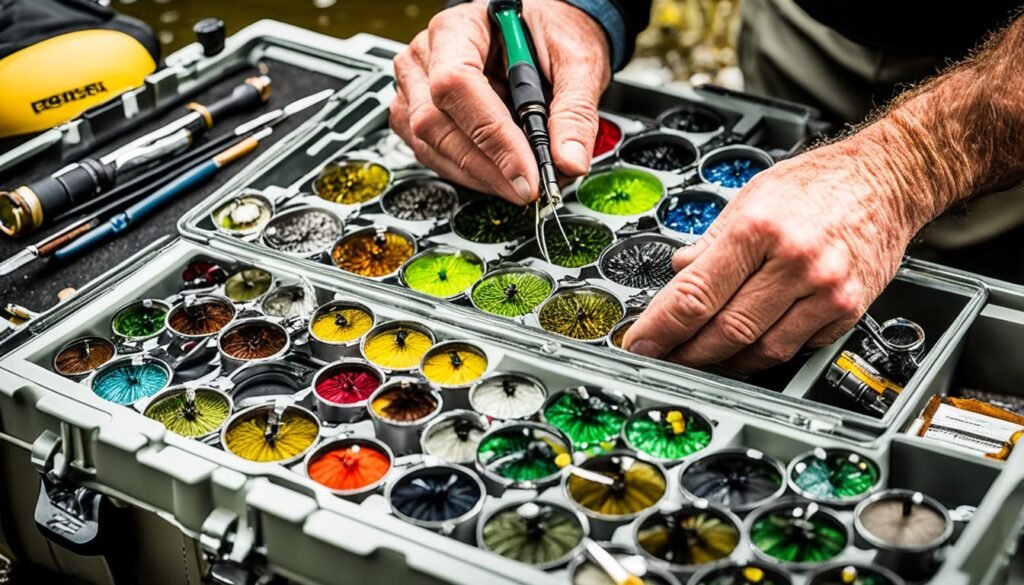
Maintenance Tips for Fly Rods
Fly rods are an essential tool for fly fishing enthusiasts. While they typically require minimal maintenance, a few simple steps can help prolong their lifespan and ensure optimal performance. By following these maintenance tips, you’ll keep your fly rod in excellent condition for years to come.
Store Your Rod Properly:
When not in use, it’s crucial to store your fly rod properly to protect it from damage during storage and travel. Invest in a sturdy rod tube that provides secure storage and transportation. This will help safeguard your fly rod from accidental impacts or bending.
Inspect for Loose Guides and Failing Wraps:
Regularly inspect your fly rod for any loose guides or failing wraps. These issues can potentially impact your casting accuracy and rod performance. If you notice any problems, it’s recommended to send your rod for preventive repair before the issues worsen. Addressing these problems promptly will help maintain the integrity of your fly rod.
Check Ferrules for Snug Fit:
The ferrules of your fly rod play a vital role in its stability and overall performance. Ensure that the ferrules fit snugly without any excessive play. Loose ferrules can contribute to rod failure or diminished casting ability. If needed, apply a small amount of rod wax to create a better fit and prevent any potential issues.
| Fly Rod Maintenance Checklist |
|---|
| Store your rod in a protective tube |
| Regularly inspect for loose guides and failing wraps |
| Check and adjust ferrules for a snug fit |
Following these maintenance tips will help ensure the longevity and performance of your fly rod. By taking proper care of this essential piece of gear, you’ll be able to fully enjoy your fly fishing adventures with confidence and reliability.
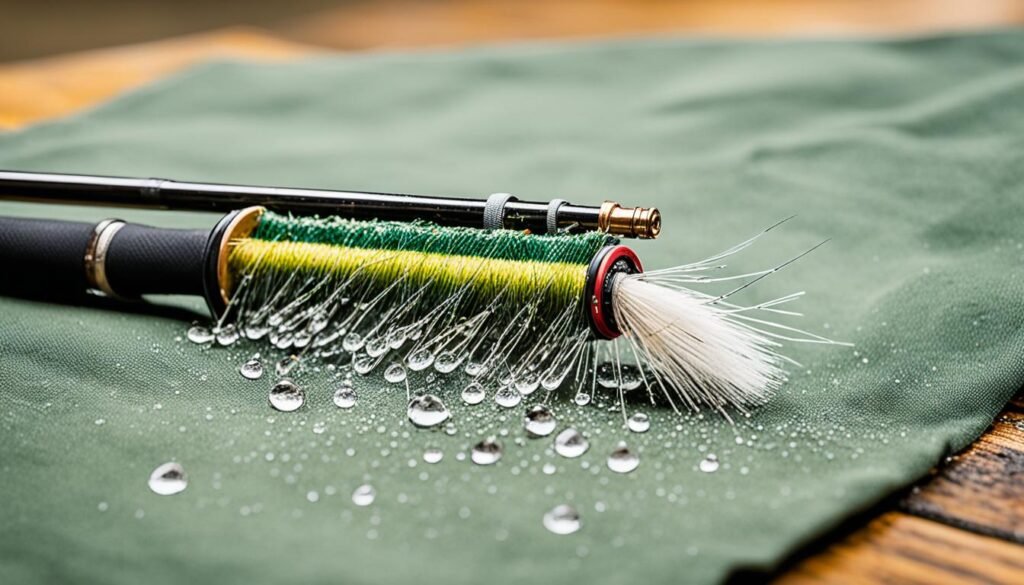
Maintenance Tips for Fly Reels
While fly reels require minimal maintenance, it is important to perform routine care to ensure their optimal performance and longevity. By following these tips, you can keep your fly reel in top-notch condition.
- Check that the reel turns smoothly and effortlessly. If you notice any stiffness or resistance, it may need some attention.
- Ensure that there isn’t excessive line on the reel. Remove any excess line to prevent tangles and improve casting accuracy.
- If your reel requires cleaning, start by removing the spool. Rinse it with water to remove any grime or debris buildup. Avoid using harsh chemicals or solvents that could damage the reel’s components.
- After cleaning, allow the spool to dry completely before reassembling it. This will help prevent corrosion and ensure smooth operation.
- Apply a small amount of reel lube or lubricating oil to the gears and other moving parts. This will help reduce friction and ensure smooth drag operation.
- Before storing your reel, make sure it is completely dry. Moisture can lead to rust and other damage, so it’s essential to keep it in a dry environment.
By incorporating these maintenance tips into your routine, you can maximize the lifespan of your fly reel and enjoy countless successful fishing trips. Remember, proper care and maintenance go a long way in preserving your gear’s performance and functionality.
“Regular maintenance is the key to ensuring your fly fishing gear performs at its best. Take the time to care for your reels, and you’ll be rewarded with exceptional performance on the water.”
Maintenance Tips for Fly Lines
Fly lines play a crucial role in your fly fishing setup, and proper maintenance is key to ensuring their optimal performance and longevity. By following these maintenance tips, you can keep your fly lines in excellent condition for successful fishing adventures.
1. Clean the Line: Over time, dirt, debris, and fish slime can accumulate on your fly line, affecting its casting and floating capabilities. To clean the line, pull out at least the first 40 feet and dampen a soft cloth with a mixture of water and mild dishwashing liquid. Gently run the cloth along the entire length of the line, removing any dirt or residue. Rinse the line with clean water until no stains appear on a clean cloth.
2. Treat the Line: To improve the line’s performance and durability, it’s essential to treat it with a suitable fly line dressing or the use of ArmorAll wipes. Apply the dressing evenly to the line, following the manufacturer’s instructions. This treatment helps rejuvenate the line’s coating, enhances its buoyancy, and reduces friction for smoother casting and retrieval.
3. Inspect the Line: Regularly inspect your fly line for any signs of wear or damage. Check for cracks, nicks, or fraying that can weaken the line and compromise its performance. If you notice any significant damage, consider replacing the line to maintain optimal fishing conditions.
4. Store the Line Properly: When not in use, store your fly lines in a cool, dry place away from direct sunlight and extreme temperatures. Prolonged exposure to heat and sunlight can cause the lines to deteriorate more quickly. Use a line spool or a fly line conditioner to prevent the line from tangling and retain its shape.
Recommended Fly Line Maintenance Schedule:
| Maintenance Activity | Frequency |
|---|---|
| Cleaning and Treating | At least once every 3-4 fishing trips or as needed |
| Inspection | After each fishing trip |
| Storage | Always after use |
By following these maintenance tips and adhering to a regular schedule, you can prolong the life of your fly lines and maintain their excellent performance, ensuring a seamless fly fishing experience.
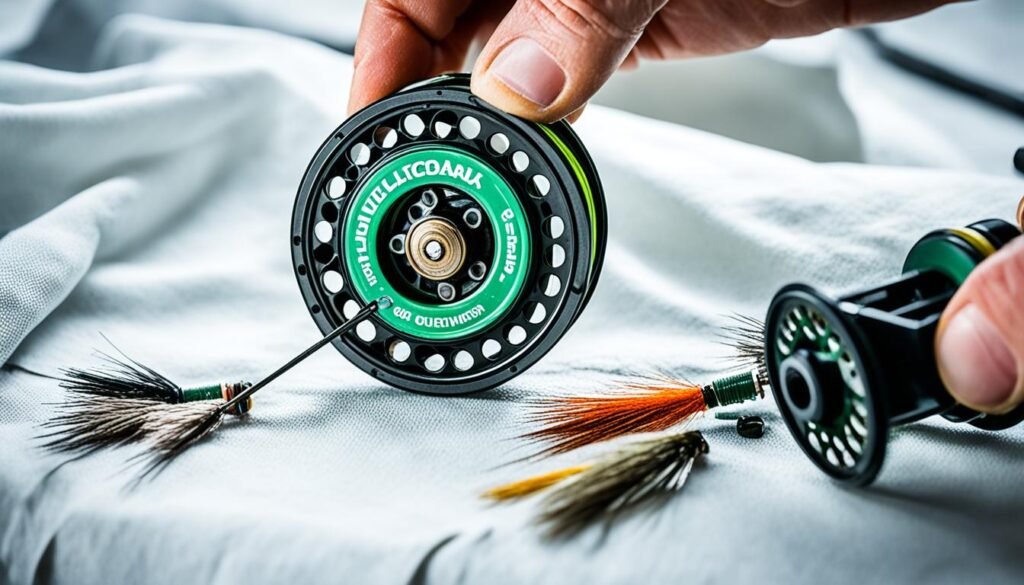
Maintenance Tips for Waders
Proper maintenance of your waders is crucial to ensure their longevity and prevent leaks, allowing you to enjoy your fly fishing adventures without any interruptions. By following these routine maintenance tips, you can keep your waders in top condition.
- When putting on or taking off your waders, be careful to avoid punctures. Sharp objects or rough surfaces can easily damage the material.
- After each use, hang your waders to dry in a well-ventilated area. This helps prevent mold and mildew growth, ensuring that they stay fresh and odor-free.
- Occasionally wash your waders with a mild detergent. Avoid using harsh chemicals or bleach, as they can degrade the fabric.
- If you notice minor leaks in your waders, use rubbing alcohol to locate the source of the leak. Once identified, apply a small amount of Aquaseal to seal the leak securely.
- To enhance the water repellency of your waders, treat them with a DWR (Durable Water Repellent) solution. This helps to ensure that water beads up and rolls off the surface, keeping you dry and comfortable.
Regular maintenance and care of your waders not only extend their lifespan but also provide you with a reliable and comfortable fishing experience. Keep your waders in great shape, and they’ll continue to be your trusted companion on all your fly fishing excursions.
Expert Tip: Choosing the Right Waders
When purchasing waders, it’s essential to choose a high-quality pair that suits your fishing needs. Look for durable materials, reinforced seams, and a comfortable fit. Consider factors such as breathability, insulation, and the type of fishing conditions you’ll encounter. Investing in the right waders from the start can make all the difference in their performance and longevity.
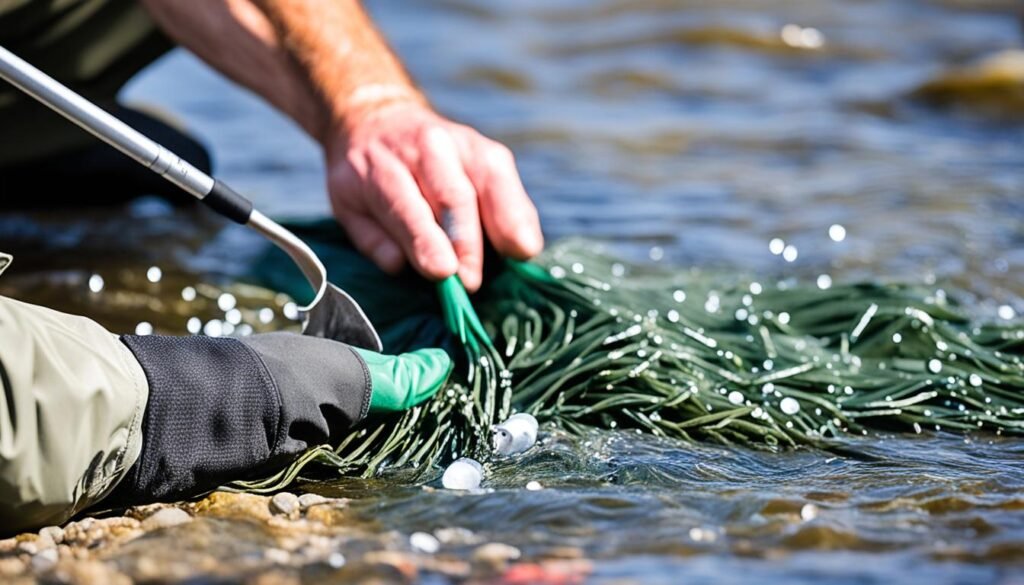
“Proper maintenance of waders is crucial to ensure their longevity and prevent leaks, allowing you to enjoy your fly fishing adventures without any interruptions.”
Inspection and Cleaning Tips
Maintaining your fly fishing gear requires regular inspection and cleaning to ensure its longevity and optimal performance. By following these tips, you can identify potential issues and keep your gear in excellent condition for your next fishing adventure.
Inspecting Your Gear
Regularly inspect your gear for signs of damage, such as loose guides, failing wraps, or bent frames. Pay attention to the integrity of each component to prevent any issues during your fishing trips. Taking the time to inspect your gear before and after each use can help address small problems before they become major ones.
Proper Cleaning Techniques
Cleaning your gear is essential to remove dirt and grime that can affect its performance. Use mild dish soap and a brush to gently scrub your gear, ensuring all surfaces are clean. Pay special attention to the guides and delicate areas that may require additional cleaning with a toothbrush or Q-tip.
Expert Tip: To clean hard-to-reach areas, such as the tiny crevices of your fly reel, use a toothbrush or Q-tip dipped in mild soap to remove any accumulated dirt.
After cleaning, rinse your gear thoroughly with clean water to remove any soap residue. Dry your gear completely before storing it to prevent the growth of mold or rust.
Fly Fishing Gear Cleaning Recommendations
| Equipment | Cleaning Method | Frequency |
|---|---|---|
| Fly Rods | Gently clean with mild dish soap and brush. Inspect for any damage. | After every fishing trip |
| Fly Reels | Remove spool and rinse with water. Apply reel lube to gears. Dry before storage. | After every fishing trip |
| Fly Lines | Clean with water and dishwashing liquid. Treat with fly line dressing. Regularly maintain for optimal performance. | Every two to three fishing trips |
| Waders | Wash with mild detergent, inspect for leaks, and repair as needed. Treat with DWR. | After every fishing trip |
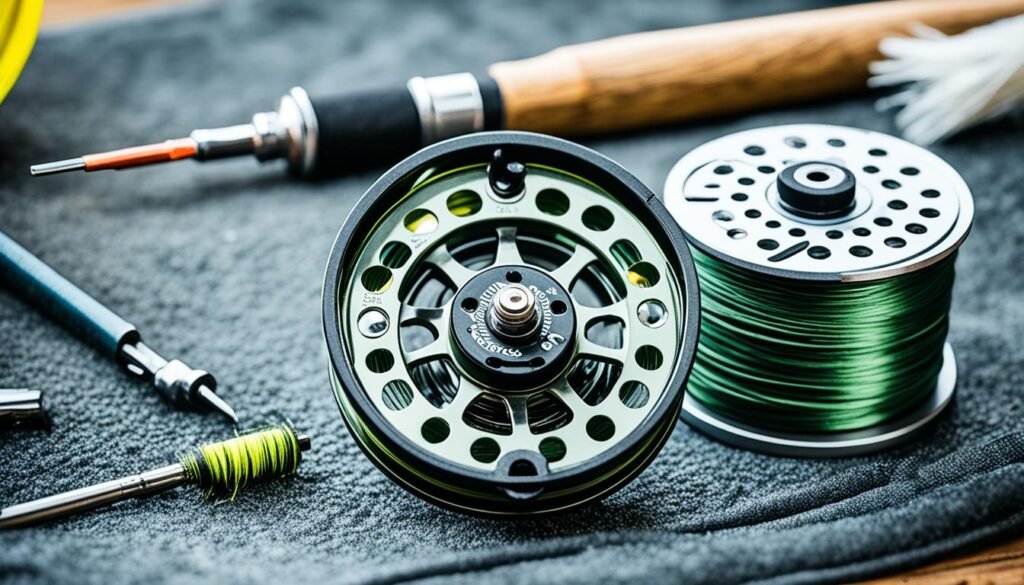
By incorporating regular inspection and cleaning into your gear maintenance routine, you can ensure that your fly fishing gear stays in excellent condition, allowing you to fully enjoy your time on the water.
Handling Tips While Fishing
Proper handling of your gear while fishing is crucial to prevent damage. By following these tips, you can maintain your fly fishing gear and ensure its longevity.
Avoid Submerging Reels in Water
Submerging your reel in water can cause damage to its internal components and compromise its performance. Whenever possible, keep your reel above the water surface to prevent water from entering and affecting its functionality.
Handle Everything Gently
When handling your fly fishing gear, including rods, reels, and lines, treat them with care. Avoid dropping or throwing them, as this can lead to scratches, dents, or other forms of damage. Handle each item gently to maintain its integrity.
Avoid High-Pressure Rinses
While it’s important to clean your gear, avoid using high-pressure water to rinse it. High-pressure rinses can force dirt and grime deeper into the reel mechanism, potentially causing damage that may be difficult to repair.
Tighten the Drag
Before every fishing session, ensure that the drag on your reel is appropriately tightened. This helps prevent water and dirt from entering the reel, which can lead to corrosion and hamper the reel’s smooth operation.
By following these handling tips, you can maintain your fly fishing gear and ensure it performs optimally for years to come.
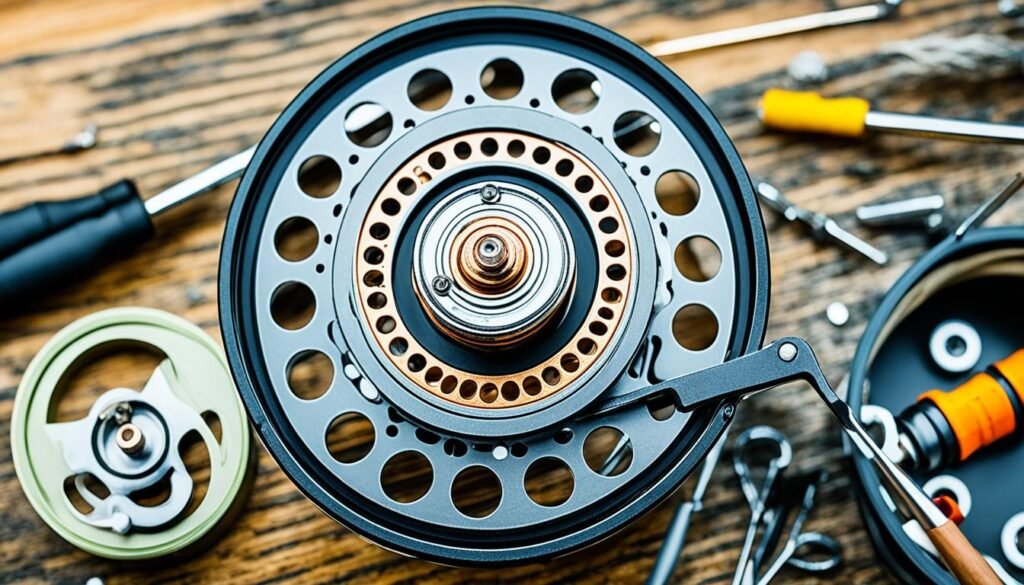
| Handling Tips While Fishing |
|---|
| Avoid submerging reels in water |
| Handle everything gently |
| Avoid high-pressure rinses |
| Tighten the drag |
Deep Cleaning Process
Deep cleaning your gear is an essential part of maintaining fly fishing equipment and ensuring its longevity. By following a proper deep cleaning process, you can keep your gear in top shape and ready for your next fishing adventure.
To deep clean your gear, follow these steps:
- 1. Disassemble the reel:
- 2. Soak the spool:
- 3. Clean all parts:
- 4. Rinse and air dry:
- 5. Lubricate the reel:
- 6. Store in a moisture-free environment:
Start by disassembling the reel to access all its components. Refer to the manufacturer’s instructions if needed. This will allow you to clean each part thoroughly.
Fill a container with warm, soapy water and submerge the spool in it. Let it soak for a few minutes to loosen any dirt or debris.
Use a toothbrush and Q-tips to clean all the reel’s parts. Scrub gently to remove any grime or residue. Pay close attention to hard-to-reach areas and crevices.
Once all the parts are clean, rinse them thoroughly with clean water to remove any soap residue. After rinsing, allow the parts to air dry completely before reassembling the reel.
Apply an appropriate grease or lubricant to the necessary parts of the reel, following the manufacturer’s recommendations. This will ensure smooth operation and protect against rust.
After deep cleaning and lubricating the reel, store it in a dry and moisture-free environment. This will prevent corrosion and maintain the reel’s integrity.
Deep cleaning your gear should be done periodically, depending on your fishing frequency. It is recommended to perform a deep clean at least once or twice a year, or more frequently if you fish regularly in saltwater or dirty environments.
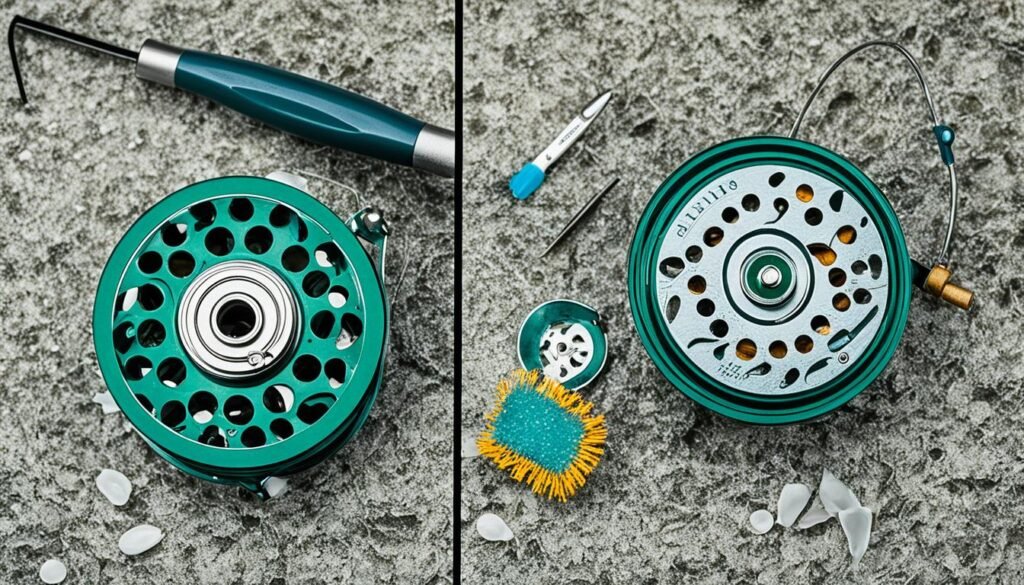
Properly deep cleaning your gear will help maintain its performance and extend its lifespan. By investing time in thorough cleaning and lubrication, you ensure that your fly fishing gear is always ready for your next angling excursion.
Tools and Storage
Maintaining your fly fishing gear involves having the right tools for the job. Here are some essential tools you’ll need to keep your gear in top condition:
- Grease: Use grease to lubricate and clean your gear, ensuring smooth operation.
- Screwdrivers: Have a set of screwdrivers on hand for any necessary repairs or adjustments.
- Soap: Mild dish soap is great for cleaning dirt and grime off your gear.
- Toothbrush: A soft-bristled toothbrush can help you reach small and delicate areas for thorough cleaning.
- Q-tips: Q-tips are perfect for precise cleaning and applying lubricants.
Once you have the tools, proper storage is crucial to protect your gear from damage. Make sure to:
- Store your gear in a dry and protected area to prevent water damage and rust.
- Avoid exposing your gear to extreme temperatures or direct sunlight, as they can cause deterioration.
- Hang your waders and dry them thoroughly after each use to prevent mold and mildew.
- Keep your gear away from sharp objects or rough surfaces to avoid scratches and tears.
By having the right tools and following proper storage practices, you can ensure that your fly fishing gear stays in the best condition possible.
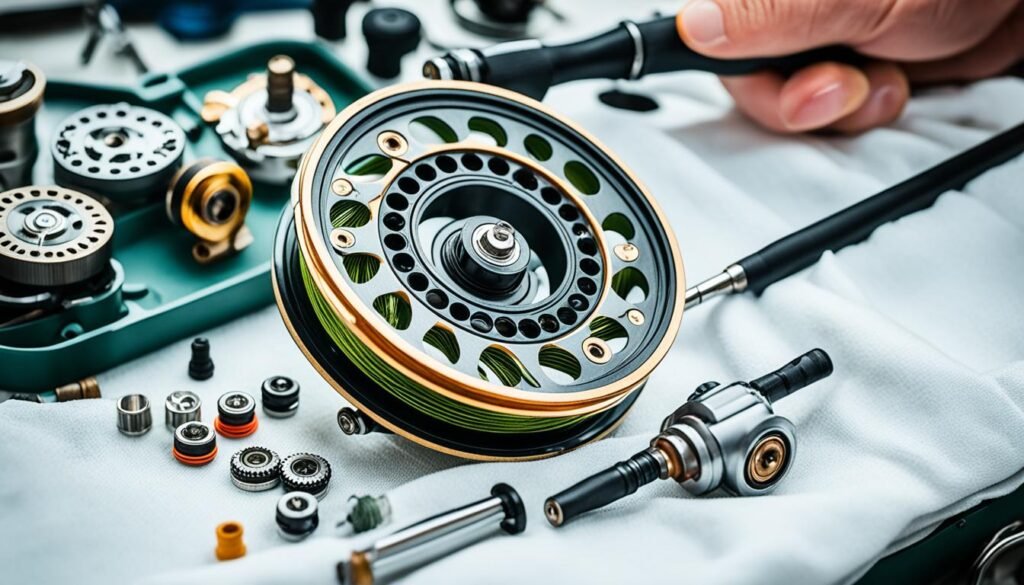
Conclusion
Regular maintenance is crucial for ensuring the longevity and optimal performance of your fly fishing gear. By following a maintenance schedule and implementing proper care techniques, you can keep your gear in excellent condition and ready for your next fishing adventure.
Taking the time to inspect your gear regularly will help identify any issues that may impact its performance, such as loose guides or failing wraps. Cleaning your gear with mild soap and a brush will remove dirt and grime, while paying attention to delicate areas with a toothbrush or Q-tip will ensure a thorough clean.
Proper storage is equally important. Storing your gear in a dry, protected area will help prevent damage and maintain its integrity. Having the necessary tools, such as grease, screwdrivers, soap, a toothbrush, and Q-tips, will make maintenance tasks easier.
By prioritizing maintenance and following these guidelines, you can enjoy your fly fishing gear for years to come. Don’t let neglect shorten the lifespan of your equipment. Take care of it, and it will reward you with exceptional performance both on and off the water.
FAQ
How often should I maintain my fly fishing gear?
It is recommended to maintain your fly fishing gear after each use and conduct a thorough inspection and cleaning at least once a month.
What should I do to maintain my fly rod?
To maintain your fly rod, store it in a tube to protect it, check for loose guides or failing wraps, and make sure the ferrules fit snugly. Apply wax if needed.
How can I maintain my fly reel?
To maintain your fly reel, check that it turns smoothly and remove any excessive line. If cleaning is required, remove the spool and rinse it with water. Apply reel lube to the gears and let it dry before storage.
What is the proper maintenance for fly lines?
Fly lines require regular cleaning. Pull out at least 40 feet of line and clean it using water and mild dishwashing liquid. Treat the line with fly line dressing or use ArmorAll wipes to improve performance and longevity.
How should I maintain my waders?
Proper maintenance of waders includes avoiding punctures, hanging them to dry after each use, washing them occasionally with a mild detergent, and treating them with Durable Water Repellent (DWR).
What should I do for inspection and cleaning of my gear?
Regularly inspect your gear for any signs of damage and clean it using mild dish soap and a brush. Pay attention to guides and delicate areas that may require a toothbrush or Q-tip for thorough cleaning.
How can I handle my gear properly while fishing?
To handle your gear properly while fishing, avoid submerging reels in water, handle everything gently to prevent scratches or scrapes, and tighten the drag to prevent water and dirt from entering the reel.
How do I perform a deep cleaning process for my gear?
To perform a deep cleaning process, disassemble the reel and soak the spool in warm, soapy water. Use a toothbrush and Q-tips to clean all parts thoroughly. Rinse and air dry before reassembling and lubricating with appropriate grease.
What are the necessary tools for gear maintenance?
The necessary tools for gear maintenance include grease, screwdrivers, soap, toothbrushes, and Q-tips. Grease is used for lubrication and cleaning. Store your gear in a dry, protected area to prevent damage.
Why is regular maintenance important for fly fishing gear?
Regular maintenance is important for fly fishing gear to ensure its longevity and peak performance. It helps prevent damage, extends lifespan, and ensures that the gear performs well when needed.

